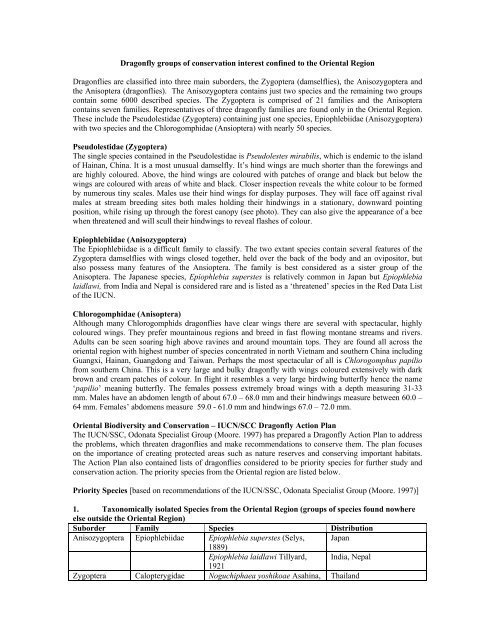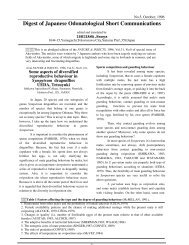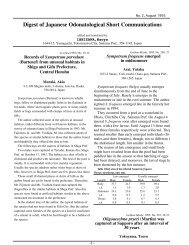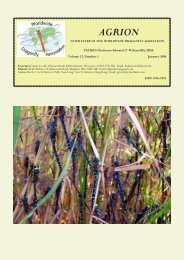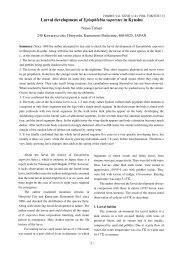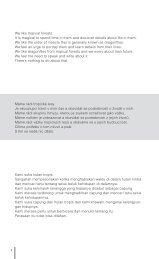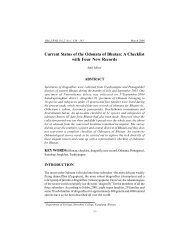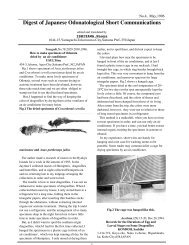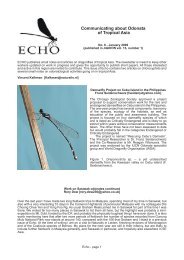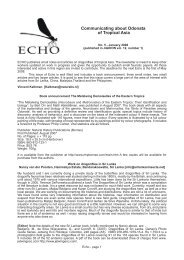Dragonfly groups of conservation interest confined ... - Asia Dragonfly
Dragonfly groups of conservation interest confined ... - Asia Dragonfly
Dragonfly groups of conservation interest confined ... - Asia Dragonfly
Create successful ePaper yourself
Turn your PDF publications into a flip-book with our unique Google optimized e-Paper software.
<strong>Dragonfly</strong> <strong>groups</strong> <strong>of</strong> <strong>conservation</strong> <strong>interest</strong> <strong>confined</strong> to the Oriental Region<br />
Dragonflies are classified into three main suborders, the Zygoptera (damselflies), the Anisozygoptera and<br />
the Anisoptera (dragonflies). The Anisozygoptera contains just two species and the remaining two <strong>groups</strong><br />
contain some 6000 described species. The Zygoptera is comprised <strong>of</strong> 21 families and the Anisoptera<br />
contains seven families. Representatives <strong>of</strong> three dragonfly families are found only in the Oriental Region.<br />
These include the Pseudolestidae (Zygoptera) containing just one species, Epiophlebiidae (Anisozygoptera)<br />
with two species and the Chlorogomphidae (Ansioptera) with nearly 50 species.<br />
Pseudolestidae (Zygoptera)<br />
The single species contained in the Pseudolestidae is Pseudolestes mirabilis, which is endemic to the island<br />
<strong>of</strong> Hainan, China. It is a most unusual damselfly. It’s hind wings are much shorter than the forewings and<br />
are highly coloured. Above, the hind wings are coloured with patches <strong>of</strong> orange and black but below the<br />
wings are coloured with areas <strong>of</strong> white and black. Closer inspection reveals the white colour to be formed<br />
by numerous tiny scales. Males use their hind wings for display purposes. They will face <strong>of</strong>f against rival<br />
males at stream breeding sites both males holding their hindwings in a stationary, downward pointing<br />
position, while rising up through the forest canopy (see photo). They can also give the appearance <strong>of</strong> a bee<br />
when threatened and will scull their hindwings to reveal flashes <strong>of</strong> colour.<br />
Epiophlebiidae (Anisozygoptera)<br />
The Epiophlebiidae is a difficult family to classify. The two extant species contain several features <strong>of</strong> the<br />
Zygoptera damselflies with wings closed together, held over the back <strong>of</strong> the body and an ovipositor, but<br />
also possess many features <strong>of</strong> the Ansioptera. The family is best considered as a sister group <strong>of</strong> the<br />
Anisoptera. The Japanese species, Epiophlebia superstes is relatively common in Japan but Epiophlebia<br />
laidlawi, from India and Nepal is considered rare and is listed as a ‘threatened’ species in the Red Data List<br />
<strong>of</strong> the IUCN.<br />
Chlorogomphidae (Anisoptera)<br />
Although many Chlorogomphids dragonflies have clear wings there are several with spectacular, highly<br />
coloured wings. They prefer mountainous regions and breed in fast flowing montane streams and rivers.<br />
Adults can be seen soaring high above ravines and around mountain tops. They are found all across the<br />
oriental region with highest number <strong>of</strong> species concentrated in north Vietnam and southern China including<br />
Guangxi, Hainan, Guangdong and Taiwan. Perhaps the most spectacular <strong>of</strong> all is Chlorogomphus papilio<br />
from southern China. This is a very large and bulky dragonfly with wings coloured extensively with dark<br />
brown and cream patches <strong>of</strong> colour. In flight it resembles a very large birdwing butterfly hence the name<br />
‘papilio’ meaning butterfly. The females possess extremely broad wings with a depth measuring 31-33<br />
mm. Males have an abdomen length <strong>of</strong> about 67.0 – 68.0 mm and their hindwings measure between 60.0 –<br />
64 mm. Females’ abdomens measure 59.0 - 61.0 mm and hindwings 67.0 – 72.0 mm.<br />
Oriental Biodiversity and Conservation – IUCN/SCC <strong>Dragonfly</strong> Action Plan<br />
The IUCN/SSC, Odonata Specialist Group (Moore. 1997) has prepared a <strong>Dragonfly</strong> Action Plan to address<br />
the problems, which threaten dragonflies and make recommendations to conserve them. The plan focuses<br />
on the importance <strong>of</strong> creating protected areas such as nature reserves and conserving important habitats.<br />
The Action Plan also contained lists <strong>of</strong> dragonflies considered to be priority species for further study and<br />
<strong>conservation</strong> action. The priority species from the Oriental region are listed below.<br />
Priority Species [based on recommendations <strong>of</strong> the IUCN/SSC, Odonata Specialist Group (Moore. 1997)]<br />
1. Taxonomically isolated Species from the Oriental Region (<strong>groups</strong> <strong>of</strong> species found nowhere<br />
else outside the Oriental Region)<br />
Suborder Family Species Distribution<br />
Anisozygoptera Epiophlebiidae Epiophlebia superstes (Selys, Japan<br />
1889)<br />
Epiophlebia laidlawi Tillyard, India, Nepal<br />
1921<br />
Zygoptera Calopterygidae Noguchiphaea yoshikoae Asahina, Thailand
1976<br />
Caliphaea confusa Hagen in<br />
Selys, 1859<br />
Bhutan, China, India, Laos,<br />
Myanmar, Nepal<br />
Caliphaea consimilis McLachlan,<br />
1894<br />
China (Guangxi, Sichuan,<br />
Yunnan and Zhejiang).<br />
Caliphaea thailandica Asahina, Thailand<br />
1976<br />
Diphlebiidae Philoganga loringae Fraser, 1927 Myanmar, Thailand<br />
Philoganga montana (Hagen in<br />
Selys, 1859)<br />
Bangladesh, India,<br />
Malaysia, Nepal<br />
Philoganga robusta Navás, 1936 China<br />
Philoganga vetusta Ris, 1912 China, Hong Kong<br />
Megapodagrionidae Lestomima flavostigma May, 1933 China<br />
Rhipidolestes aculeatus Ris, 1912 China (Taiwan), Japan<br />
Rhipidolestes alleni Wilson, 2000 China (Guangxi)<br />
Rhipidolestes apicatus Navás, China (Zhejiang)<br />
1934<br />
Rhipidolestes asatoi Asahina, Japan (Kyushu)<br />
1994<br />
Rhipidolestes bastiaani Zhu & China (Shaanxi)<br />
Yang, 1998<br />
Rhipidolestes cyan<strong>of</strong>lavus Wilson, China (Guangdong)<br />
2000<br />
Rhipidolestes hiraoi Yamamoto, Japan (Shikoku)<br />
1955<br />
Rhipidolestes janetae Wilson, China (Hong Kong)<br />
1997<br />
Rhipidolestes jucundus Lieftinck, China (Fujian)<br />
1948<br />
Rhipidolestes malaisei Lieftinck, Myanmar<br />
1948<br />
Rhipidolestes nectans (Needham, China (Zhejiang)<br />
1929)<br />
Rhipidolestes okinawanus Japan (Okinawa)<br />
Asahina, 1951<br />
Rhipidolestes owadai Asahina, Vietnam<br />
1997<br />
Rhipidolestes rubripes (Navás, China (Jiangxi)<br />
1936)<br />
Rhipidolestes truncatidens China (Fujian, Guangdong)<br />
Schmidt, 1931<br />
Rhipidolestes yangbingi Davies, China (Sichuan)<br />
1998<br />
Devadatta argyoides (Selys, 1859) Indonesia, Myanmar,<br />
Singapore, Thailand<br />
Devadatta ducatrix Lieftinck, China (Guangxi), Vietnam<br />
1969<br />
Devadatta multinervosa Fraser, Laos<br />
1933<br />
Devadatta podolestoides Laidlaw,<br />
1934<br />
Indonesia, and Malaysia<br />
(Borneo)<br />
Philosina buchi Ris, 1917 China (Fujian, Guangdong,<br />
Guangxi)<br />
Philosina alba Wilson, 1999 China (Guangdong,
Pseudolestidae Pseudolestes mirabilis Kirby,<br />
1900<br />
Anisoptera Onychothemistinae Onychothemis abnormis Brauer,<br />
1868<br />
Onychothemis celebensis Ris,<br />
1912<br />
Onychothemis coccinea Lieftinck,<br />
1953<br />
Onychothemis culminicola Förster,<br />
1904<br />
Onychothemis testacea Laidlaw,<br />
1902<br />
Hainan)<br />
China (Hainan)<br />
Indonesia, Philippines<br />
Indonesia (Celebes)<br />
Indonesia, Malaysia<br />
Indonesia, Malaysia,<br />
Myanmar, Thailand<br />
China (Guangdong,<br />
Guangxi, Hainan, Hong<br />
Kong, Taiwan), Indonesia,<br />
Malaysia, Myanmar, Sri<br />
Lanka, Thailand, Vietnam<br />
2. Monotypic Genera from the Oriental Region (genera containing only one species)<br />
Zygoptera Megapodagrionidae Agriomorpha fusca May, 1933 China (Guangdong,<br />
Guangxi, Hainan, Hong<br />
Kong)<br />
Synlestidae Sinolestes editus Needham, 1930 China (Fujian, Guangdong,<br />
Guangxi and Zhejiang)<br />
Anisoptera Gomphidae Gastrogomphus abdominalis China<br />
(McLachlan, 1884)<br />
Labrogomphus torvus Needham,<br />
1931<br />
China (Guangdong,<br />
Guangxi, Hainan, Hong<br />
Kong)<br />
3. Dragonflies with unusual biology from the Oriental Region<br />
Zygoptera Coeagrionidae Mortonagrion hirosei Asahina,<br />
1972<br />
China (Hong Kong), Japan<br />
(salt tolerant species found<br />
to associate with<br />
Phragmites sp. reed)<br />
Reference<br />
MOORE, N.W., 1997. Dragonflies: Status Survey and Conservation Action Plan. IUCN/SSC Odonata<br />
Specialist Group. 27 pp.


